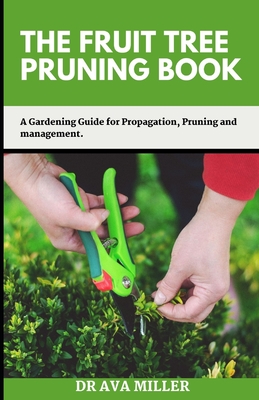The Fruit Tree Pruning Book: A Gardening Guide for Propagation, Pruning and Management.

The Fruit Tree Pruning Book: A Gardening Guide for Propagation, Pruning and Management.
BASIC PRINCIPLES ON HOW TO PRUNE YOUR FRUIT TREES Within a few years of lovingly planting fruit trees, most folks find themselves with scraggly overgrown bushes, rather than the Garden of Eden they had envisioned. The key to keeping fruit trees attractive and productive is annual pruning. Fruit growers manipulate tree canopies to maximize fruit production by pruning to remove limbs or shoots or by bending limbs or shoots in specific orientations. Pruning and training are horticultural manipulations done to modify naturally occurring growth patterns within plants. The primary processes being modified are apical dominance (see below) and the natural flowering and/or fruiting characteristics of the trees. Timing and method of fruit tree pruning can enhance the amount and quality of your crop. Learning when to prune fruit trees will also create an open scaffold that is strong enough to bear all those beautiful fruits without breaking. Proper pruning methods and timing are the keys to bountiful crops and healthy trees. Most fruit trees don't need pruning annually once they have been trained. Initial fruit tree pruning is important to help young trees produce thick stems and open canopies where light and air can enter and promote flowering, as well as reduce fungal and bacterial diseases. The best time for pruning fruit trees is at planting and in subsequent years, in early spring before buds break and trees are still dormant. There are two types of pruning cuts, "heading" and "thinning". Thinning refers to removing a limb or shoot at its point of origin along an older branch. Thinning cuts do not induce vegetative growth near the pruning cut and are usually preferred for minimizing tree size and for removing excess shoots. Thinning cuts are also used in older trees as a method of fruiting shoot renewal. When a shoot that fruited the previous season is removed there are buds imbedded in the bark in the collar of the shoot that are released from dormancy and may develop into desirable fruiting shoots for the next year. Want to discover more? Read "The Fruit Tree Pruning Book" now.
PRP: 92.92 Lei
Acesta este Pretul Recomandat de Producator. Pretul de vanzare al produsului este afisat mai jos.
83.63Lei
83.63Lei
92.92 LeiLivrare in 2-4 saptamani
Descrierea produsului
BASIC PRINCIPLES ON HOW TO PRUNE YOUR FRUIT TREES Within a few years of lovingly planting fruit trees, most folks find themselves with scraggly overgrown bushes, rather than the Garden of Eden they had envisioned. The key to keeping fruit trees attractive and productive is annual pruning. Fruit growers manipulate tree canopies to maximize fruit production by pruning to remove limbs or shoots or by bending limbs or shoots in specific orientations. Pruning and training are horticultural manipulations done to modify naturally occurring growth patterns within plants. The primary processes being modified are apical dominance (see below) and the natural flowering and/or fruiting characteristics of the trees. Timing and method of fruit tree pruning can enhance the amount and quality of your crop. Learning when to prune fruit trees will also create an open scaffold that is strong enough to bear all those beautiful fruits without breaking. Proper pruning methods and timing are the keys to bountiful crops and healthy trees. Most fruit trees don't need pruning annually once they have been trained. Initial fruit tree pruning is important to help young trees produce thick stems and open canopies where light and air can enter and promote flowering, as well as reduce fungal and bacterial diseases. The best time for pruning fruit trees is at planting and in subsequent years, in early spring before buds break and trees are still dormant. There are two types of pruning cuts, "heading" and "thinning". Thinning refers to removing a limb or shoot at its point of origin along an older branch. Thinning cuts do not induce vegetative growth near the pruning cut and are usually preferred for minimizing tree size and for removing excess shoots. Thinning cuts are also used in older trees as a method of fruiting shoot renewal. When a shoot that fruited the previous season is removed there are buds imbedded in the bark in the collar of the shoot that are released from dormancy and may develop into desirable fruiting shoots for the next year. Want to discover more? Read "The Fruit Tree Pruning Book" now.
Detaliile produsului








